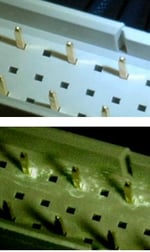Flux is used when soldering connectors to eliminate oxides from the metals. During testing, flux that has not been cleaned off the connector can create errors that cause test failures.
Errors caused by flux residue manifest as unexplainable opens or high resistance errors. This is because flux can create a barrier between the connector and mating adapter that reads as an error.
Leftover flux can also create a conductive path between pins where there should be no connection. This error will be reported as an insulation resistance failure during high voltage testing.
To keep flux from damaging cables and causing failures, be sure to clean off all traces of flux. It can appear as a brown tint or a white powder and can be removed using solvents like alcohol. Be careful when using no-clean flux as it is invisible and nearly impossible to remove even with solvents.
Learn more about flux and testing in the Cirris Learning Center.

Further Reading:
What is the Difference between High Voltage and Hipot?
What Do We Mean By “Low Voltage Testing?”
3 Ways to Set Yourself Up for Wiring Errors